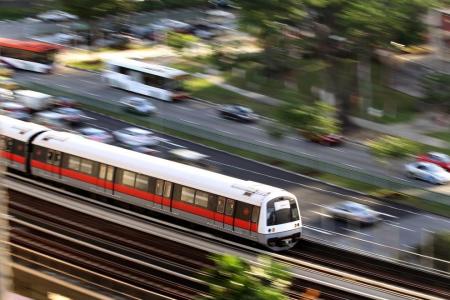SMRT announces closures and shorter hours on NSEWL for re-signalling works
LTA, SMRT say measures necessary for extended engineering hours to hasten re-signalling works
For two whole Sundays, 17 East-West Line (EWL) MRT stations and two North-South Line (NSL) stations will be closed for extended engineering hours, train operator SMRT and the Land Transport Authority (LTA) said in a joint statement yesterday.
In addition, from Dec 8 to Dec 31, the 17 EWL stations from Tiong Bahru to Tuas Link as well as Bukit Batok and Bukit Gombak stations on the NSL will close earlier on Fridays and Saturdays at 11pm and open later on Saturdays and Sundays at 8am.
This will give LTA and SMRT more engineering and track access time to accelerate re-signalling works on the EWL, the organisations said.
The two NSL MRT stations are also affected as the works will extend to Jurong East MRT station, a heavily used intersection of the North-South and East-West Lines (NSEWL), they added.
Shuttle buses will be provided along affected MRT stations during affected hours, and fares will follow the rail fare structure.
LTA's Chief Executive Ngien Hoon Ping said: "The additional engineering hours are very precious as it will accelerate the implementation of the new signalling system for the EWL and provide additional maintenance hours for the entire NSEWL network."
In the first half of next year, reduced train service hours will also be introduced along other stretches of the NSEWL.
A software glitch as a result of compatibility issues between an old and a new signalling system on the EWL caused a train collision at Joo Koon MRT station last Wednesday, injuring 38 people.
A train headed towards Tuas Link hit a stalled train, which had no passengers.
In a second press conference yesterday to address the incident, SMRT, LTA and signalling system supplier Thales said the collision was caused by an unexpected disabling of a protective "bubble" - which ensures a safe distance between trains - around the stalled train, which was not detected until it reached Pioneer MRT station.
When the second train arrived, it moved forward automatically as there was no protective bubble around the stalled train, resulting in the collision.
To avoid the risk of a repeat incident, the two signalling systems will remain separated - as they have been since Monday - till next June.
This means commuters travelling between Tuas Link and Pasir Ris on the EWL will have to get off at Joo Koon, take a bus to the next stop at Gul Circle to continue westwards on a stretch of the line which runs on the new signalling system.
In the opposite direction, they will have to get off at Gul Circle, and take a bus to Joo Koon to continue eastwards on the rest of the EWL, which is still on the old signalling system.
Transport Minister Khaw Boon Wan said during the conference that while Thales was given a "challenging situation" of dealing with two different signalling systems on the EWL, they could have done better.
Thales apologised for the collision and said it has identified the "unexpected condition" responsible for the collision.
Get The New Paper on your phone with the free TNP app. Download from the Apple App Store or Google Play Store now


